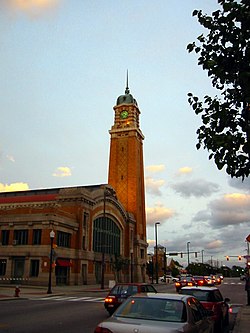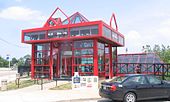Neighborhood of Cleveland in Cuyahoga County, Ohio, United States
| Ohio City | |
|---|---|
| Neighborhood of Cleveland | |
 | |
 | |
| Country | United States |
| State | Ohio |
| County | Cuyahoga County |
| City | Cleveland |
| Population | |
| • Total | 8,389 |
| Demographics | |
| • White | 60.4% |
| • Black | 28.1% |
| • Hispanic (of any race) | 14.6% |
| • Asian and Pacific Islander | 2.1% |
| • Mixed and Other | 9.4% |
| Time zone | UTC-5 (EST) |
| • Summer (DST) | UTC-4 (EDT) |
| ZIP Codes | 44113, 44102 |
| Area code | 216 |
| Median income | $40,170 |
| Source: 2020 U.S. Census, City Planning Commission of Cleveland | |
| Ohio City Preservation District | |
| U.S. National Register of Historic Places | |
| U.S. Historic district | |
 The West Side Market The West Side Market | |
   | |
| Location | Roughly Franklin Blvd. NW., W. 38th St., Bridge Ave. NW., & W. 44th St., & Stone, W. 25th, Bridge Ave. NW., & W. 28th, Cleveland, Ohio |
|---|---|
| Coordinates | 41°29′1″N 81°42′37″W / 41.48361°N 81.71028°W / 41.48361; -81.71028 |
| Architectural style | Greek Revival, Italianate, Queen Anne |
| NRHP reference No. | 89000435 |
| Added to NRHP | May 25, 1989 |
Ohio City is one of the oldest neighborhoods in Cleveland, Ohio. It is located immediately west of the Cuyahoga River.
History
The City of Ohio became an independent municipality on March 3, 1836, splitting from Brooklyn Township. The city grew from a population of 2,400 people in the early 1830s to over 4,000 in 1850. The municipality was annexed by Cleveland on June 5, 1854.
James A. Garfield, who became the 20th president of the United States, frequently preached at Franklin Circle Christian Church in 1857. Franklin Circle Christian Church is located at the intersection of Franklin Boulevard and Fulton Road.
The birthplace of John Heisman, famous for the annual Heisman Trophy awarded to the best player in college football, is located in Ohio City. He was born in the neighborhood in 1869, and an Ohio Historical Society marker stands in commemoration near the corner of Bridge Avenue and West 29th Place.
Features
The salient feature of Ohio City's business district is the historic West Side Market, built in 1912. The European-styled market, located at the intersection of Lorain Avenue and West 25th Street, draws an estimated one million visitors annually. Located north of the West Side Market is The Ohio City Fresh Food Collaborative, one of the largest contiguous urban farms in America. The operation includes a farm, retail farm stand and community kitchen on a 6-acre city parcel. Ohio City chef Parker Bosley was an early farmer's market supporter.
Ohio City contains the largest concentration of craft breweries in Cleveland, which includes Hansa Brewing, Market Garden Brewery, Nanobrew, Platform Beer, Saucy Brew Works, Bad Tom Smith Brewing, and the state of Ohio's oldest microbrewery, the Great Lakes Brewing Company. (Both Market Garden and Great Lakes have fullscale brewpubs adjacent to the West Side Market, with the latter occupying a building that formerly housed the Market Tavern, a pub frequented by Eliot Ness.)
Saint Ignatius High School, a Jesuit college prep school, is located near the West Side Market. Founded in 1886, the school has a long list of distinguished graduates and is a perennial contender in several OHSAA sports.
The Cleveland Hostel, which opened in 2012, is the first and only hostel in the city of Cleveland. The hostel is located on West 25th Street and Chatham Avenue adjacent to the W.25th Street Station on the RTA Red Line.
Serving as the only auxiliary location for the Cleveland Museum of Art, the Transformer Station, located at Church and West 29th Street, functions primarily as its contemporary art gallery space.
St. John's Episcopal Church, located at Church and West 26th Street, is the oldest consecrated building in Cuyahoga County and is the mother church of the current Episcopal cathedral located in downtown Cleveland. The church was one of the final stops on the Underground Railroad in Northeastern Ohio, and the remains of an entrance to a tunnel leading to the banks of the nearby Cuyahoga River can still be seen in the basement. Several nearby streets retain church-related names, such as Vestry. An Episcopal parish continues to worship in the space, although membership has dramatically declined with the demographic changes in the neighborhood.
The Carnegie West Branch of Cleveland Public Library has been in continuous operation since opening in 1910. Designed by Edward Tilton, the architect of four buildings on Ellis Island in New York, Carnegie West features a modified Renaissance and classical style exterior.
Ohio City has experienced a massive building and development boom in recent years. As such, the neighborhood has attracted young professionals, microbreweries, artisans, and locally owned shops and restaurants. It is widely regarded as one of Ohio's most trendy and welcoming neighborhoods for all ages, ethnicities, and lifestyles.
Demographics
| This section does not cite any sources. Please help improve this section by adding citations to reliable sources. Unsourced material may be challenged and removed. Find sources: "Ohio City, Cleveland" – news · newspapers · books · scholar · JSTOR (September 2024) (Learn how and when to remove this message) |
The demographics of Ohio City have changed rather dramatically in the latter half of the 20th century and first part of the 21st. Originally composed mainly of English and German descendants, many Eastern European immigrants moved into the area during the migrations in the first half of the 20th century. In the 1960s and 1970s, as Cleveland expanded and the wealthy moved to the surrounding suburbs (including Parma, Brooklyn, and Lakewood), the percentage of African Americans increased. The size of the Latino community has also increased. However, Cleveland City Council, with an eye on redevelopment and with the incentive of tax breaks, has lured an increasing number of suburbanites of all backgrounds back into the Ohio City area. This has led to a diverse community.
Gallery
-
 Looking down Ohio City's retail hub, West 25th Street
Looking down Ohio City's retail hub, West 25th Street
-
 Ohio City in the Spring, near the corner of West 28th Street and Bridge Avenue
Ohio City in the Spring, near the corner of West 28th Street and Bridge Avenue
-
 Looking northeast on Market Street towards West 25th Street with The West Side Market in the background
Looking northeast on Market Street towards West 25th Street with The West Side Market in the background
-
 Ohio City's rapid transit station
Ohio City's rapid transit station
-
Saint Ignatius High School main building, completed 1891
-
 A locally used flag for the neighborhood of Ohio City.
A locally used flag for the neighborhood of Ohio City.
References
- ^ "Cleveland Neighborhoods and Wards: Ohio City Neighborhood Factsheet (2021)" (PDF). The Center for Community Solutions (Cleveland). Retrieved June 3, 2022.
- "Census 2010 PL94-171 Redistricting Data for Cleveland's Statistical Planning Areas (Yr 2000 boundaries)" (PDF). Cleveland City Planning Commission. City of Cleveland. Retrieved April 3, 2013.
- "National Register Information System". National Register of Historic Places. National Park Service. April 15, 2008.
- "John W. Heisman Birth Site Historical Marker". www.hmdb.org.
- About at WestSideMarket.org
- "Protected Blog › Log in". ohiocityfarm.wordpress.com.
- Joe Crea, cleveland com (February 2, 2010). "Local-food advocates pay tribute to Parker Bosley". cleveland. Retrieved December 26, 2023.
- Around the Brewpub at Great Lakes Brewing Company
- "The Cleveland Hostel". The Cleveland Hostel.
- Steven Litt (January 28, 2013). "Transformer Station is set to transform Cleveland's art scene and spur growth in Ohio City". The Plain Dealer.
- "Carnegie West".
External links
41°29′03″N 81°42′41″W / 41.484195°N 81.711295°W / 41.484195; -81.711295
| National Register of Historic Places in Ohio | ||
|---|---|---|
| Lists by county |
|   |
| Lists by city | ||
| Other lists | ||
| Places adjacent to Ohio City, Cleveland | ||||||||||||||||
|---|---|---|---|---|---|---|---|---|---|---|---|---|---|---|---|---|
| ||||||||||||||||
- Ohio City, Cleveland
- Neighborhoods in Cleveland
- James A. Garfield
- English-American culture in Ohio
- German-American culture in Cleveland
- 1836 establishments in Ohio
- Populated places established in 1836
- Historic districts in Cleveland
- National Register of Historic Places in Cleveland, Ohio
- Populated places established in 1818
- Historic districts on the National Register of Historic Places in Ohio
- Former municipalities in Ohio